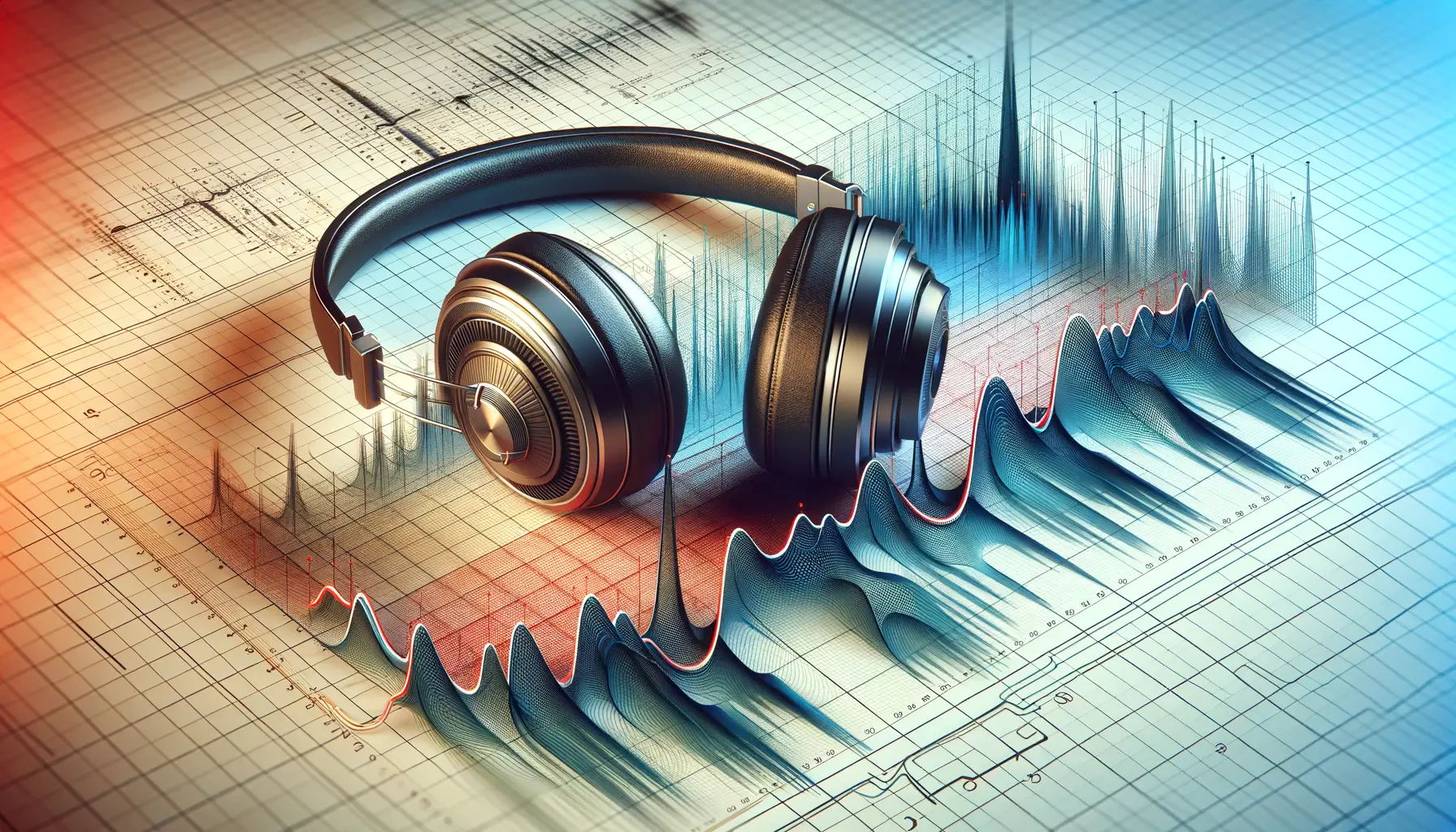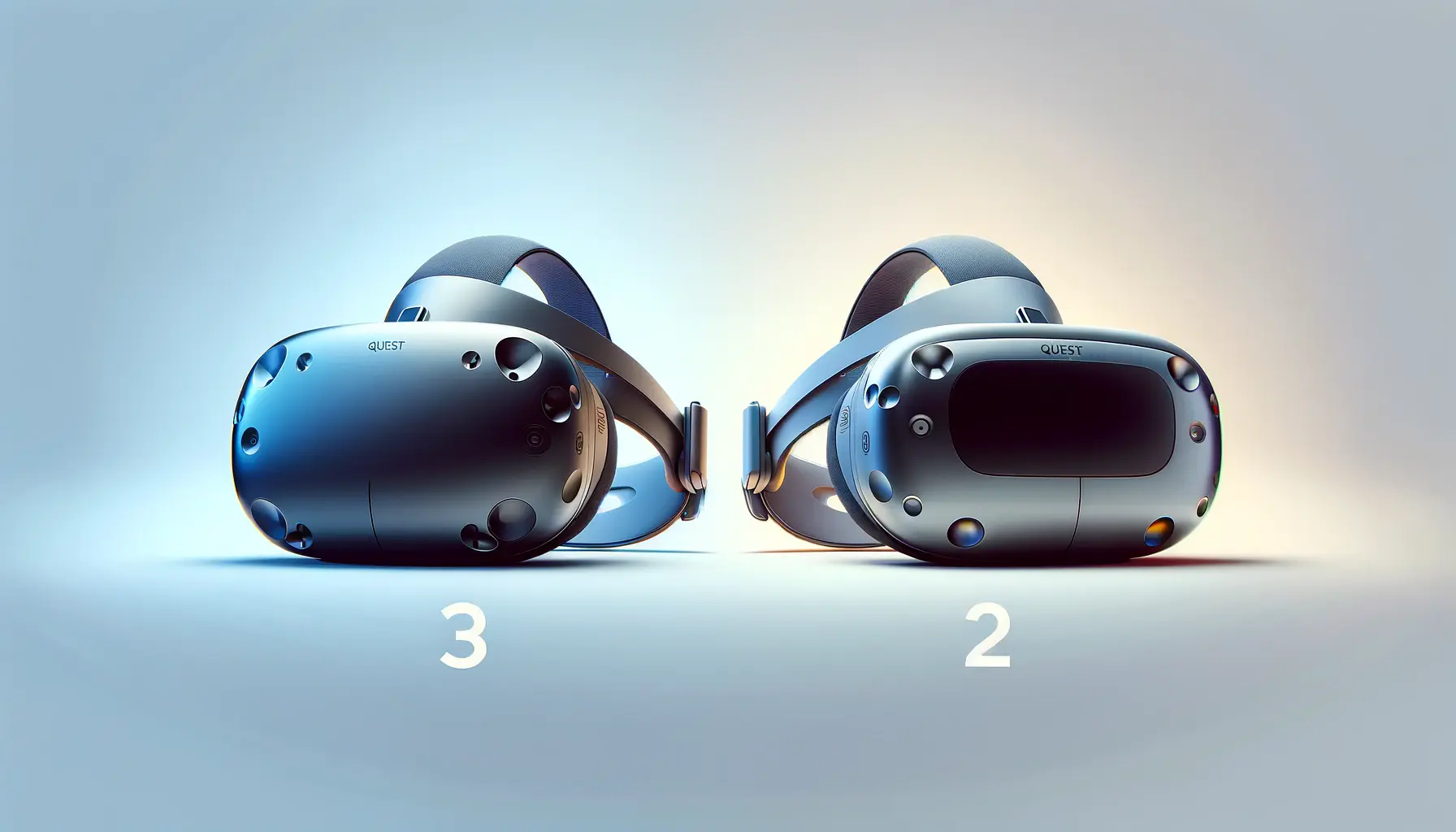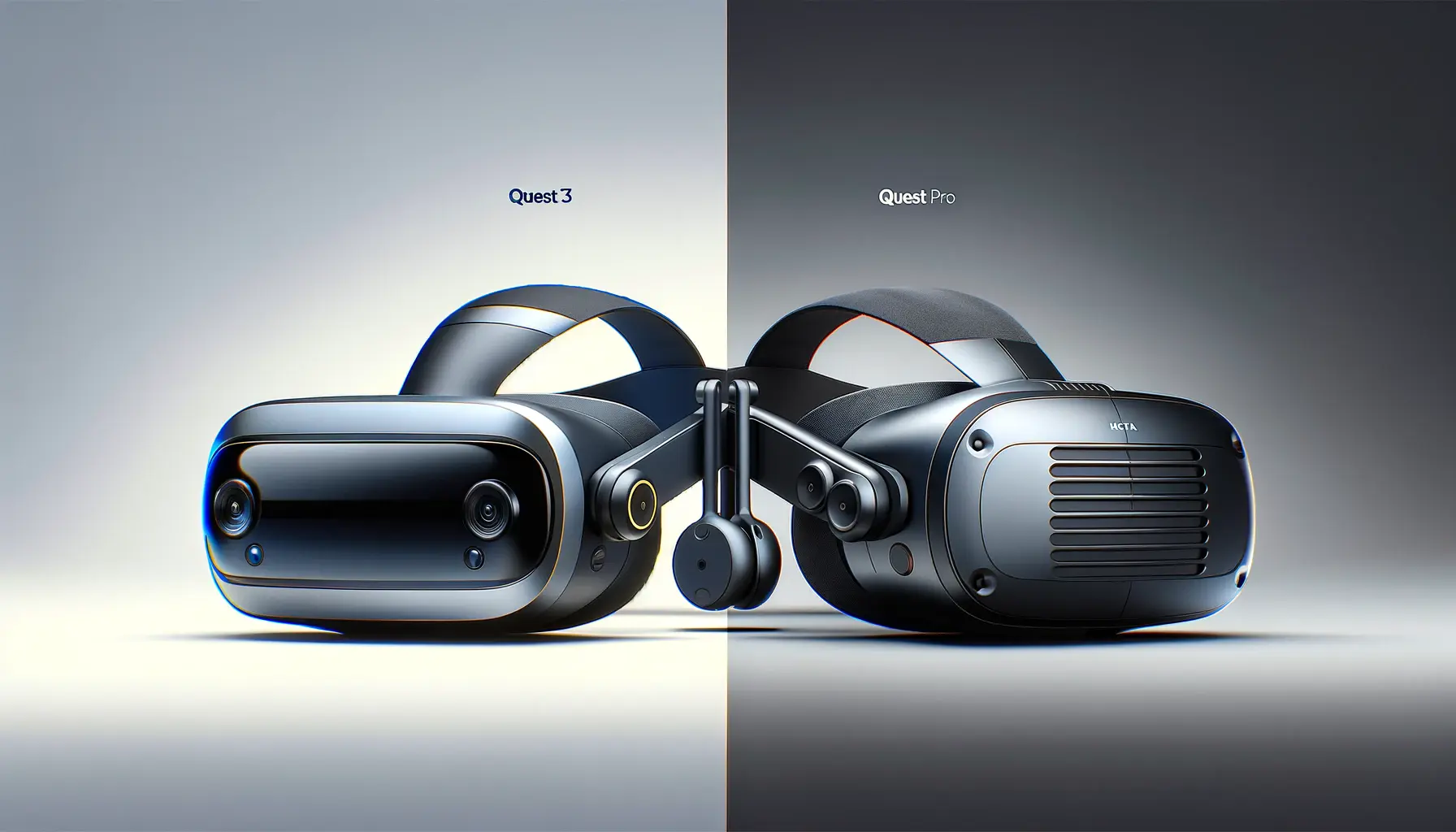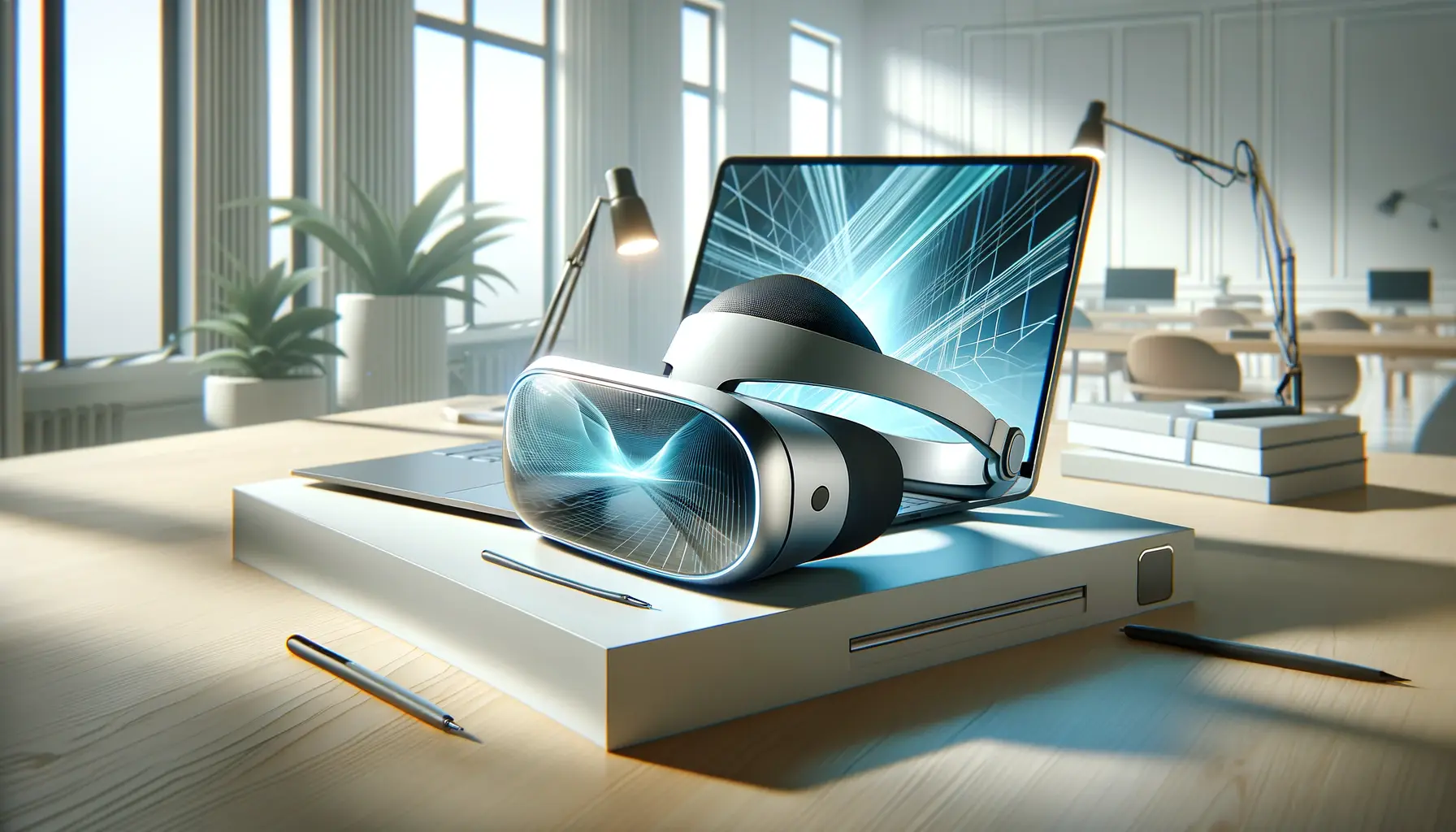The Meta Quest 3 marks a significant leap forward in the realm of virtual reality, particularly in the auditory experience it offers.
As we delve into the intricate world of audio within the Meta Quest 3, it becomes evident that the developers have placed a substantial emphasis on enhancing the sound quality to create a more immersive and realistic VR environment.
This exploration is not just about the technical specifications; it’s about understanding how these audio features contribute to the overall VR experience, making it more engaging and lifelike for users.
Audio plays a pivotal role in virtual reality, acting as a critical element that can either make or break the sense of presence within a digital environment.
The Quest 3’s audio system has been engineered with this in mind, aiming to deliver a spatial audio experience that is both clear and immersive.
By focusing on the nuances of sound, from the whisper of the wind to the thunderous roar of an engine, the Quest 3 seeks to transport users not just visually but aurally into another world.
- Introduction to Quest 3’s Audio Capabilities
- Enhancing User Experience with Audio Customization
- Audio Immersion in Gaming and Entertainment
- Audio Innovations for Content Creators
- Challenges and Solutions in VR Audio
- Future Directions in VR Audio Technology
- Integrating Audio with Other VR Technologies
- Concluding Insights on Quest 3’s Audio Evolution
- Quest 3 Audio Features FAQ
Introduction to Quest 3’s Audio Capabilities
Revolutionizing VR Sound with Spatial Audio
The introduction of spatial audio in the Quest 3 represents a significant advancement in how sound is delivered in virtual environments.
Spatial audio, by its design, mimics the way we hear sounds in the real world, with directions and distances playing key roles in the perception of audio.
This technology allows users to pinpoint the location of sounds within the VR space, enhancing the realism of virtual experiences.
Whether it’s the rustling of leaves behind you or the footsteps of an adversary in a game, spatial audio makes these sounds more lifelike and directional, thereby increasing the user’s immersion and engagement.
Moreover, the Quest 3’s audio system is designed to minimize distortion and maximize clarity, ensuring that every sound, from the subtle to the dramatic, is heard with precision.
This clarity not only improves the gaming and entertainment experience but also enhances communication in social and professional VR applications, making interactions within the virtual space as natural as those in the real world.
Integrated Audio Technology
One of the standout features of the Quest 3’s audio system is its integrated audio technology.
Unlike traditional VR headsets that may require external headphones or earbuds for a complete audio experience, the Quest 3 incorporates built-in speakers that deliver sound directly to the user’s ears.
This design choice not only simplifies the user setup but also ensures that the audio experience is seamless and unencumbered by additional accessories.
The integrated speakers are carefully positioned to optimize sound delivery, ensuring that users can enjoy a high-quality audio experience without the need for external devices.
The benefits of integrated audio extend beyond convenience and quality; they also contribute to a more immersive VR experience.
By eliminating the barriers between the user and the virtual environment, the Quest 3’s audio system allows for a deeper sense of presence.
Users can move freely within their physical space without worrying about dislodging earbuds or dealing with the discomfort of headphones, making the virtual experience more comfortable and engaging over longer periods.
The Quest 3’s audio features, including spatial audio and integrated technology, are designed to enhance the virtual reality experience, making it more immersive and realistic for users.
Enhancing User Experience with Audio Customization
The Quest 3 goes beyond just providing high-quality audio; it introduces an array of customization options that allow users to tailor their auditory experience to their preferences.
This level of personalization is not just about adjusting volume levels; it encompasses a variety of settings that can significantly alter how users perceive and interact with the virtual world.
By offering these customization features, the Quest 3 ensures that the audio experience is not one-size-fits-all but can be adapted to suit individual needs and preferences.
Personalized Audio Settings
At the heart of the Quest 3’s audio customization are the personalized audio settings.
These settings include:
- Equalizer adjustments: Users can tweak the bass, mid, and treble levels to match their preferred listening profile.
- Volume control for different applications: This allows for the differentiation of volume levels between games, social experiences, and media playback, ensuring that each application has the ideal audio setting.
- 3D audio intensity: Users can adjust the intensity of the spatial audio effect, enhancing or reducing the perception of sound directionality and distance based on personal preference.
These customizable settings empower users to create an audio environment that not only enhances their immersion into the virtual world but also caters to their comfort and auditory health.
By allowing for such detailed adjustments, the Quest 3 acknowledges the diverse needs of its user base, ensuring that everyone can enjoy a rich and fulfilling audio experience.
Adaptive Audio Environments
Beyond personal adjustments, the Quest 3 introduces adaptive audio environments.
These environments automatically adjust audio settings based on the virtual context or the physical environment of the user.
For instance:
- In noisy environments, the system can increase voice clarity and reduce background noise during social interactions or gaming sessions.
- For immersive experiences like virtual concerts or environmental simulations, the audio settings can adapt to emphasize spatial effects and environmental sounds, making the experience more realistic.
This adaptability not only enhances the user’s immersion and enjoyment but also showcases the Quest 3’s advanced understanding of how audio plays a crucial role in the virtual reality experience.
By automatically adjusting to provide the best audio experience in any given scenario, the Quest 3 sets a new standard for VR audio quality and customization.
The Quest 3’s emphasis on audio customization and adaptive environments reflects a deep understanding of user needs and the importance of sound in creating immersive virtual experiences.
Audio Immersion in Gaming and Entertainment
The Quest 3’s audio features are particularly transformative in the realms of gaming and entertainment, where sound plays a critical role in creating immersive and engaging experiences.
The headset’s advanced audio capabilities, combined with its spatial audio technology, elevate the gaming experience by providing a level of immersion that closely mimics real-world auditory experiences.
This section explores how the Quest 3’s audio features enhance the virtual reality experience for gamers and entertainment enthusiasts alike.
For gamers, the Quest 3’s audio system does more than just deliver sound; it creates an auditory landscape that can influence gameplay and strategy.
The ability to hear footsteps approaching from behind or to distinguish the direction of gunfire adds a tactical layer to gaming that was previously reserved for high-end audio setups.
This level of detail not only enhances the player’s immersion but also provides a competitive edge in gameplay.
Enhanced Narrative and Environmental Sounds
In the context of VR entertainment, such as movies or interactive experiences, the Quest 3’s audio capabilities enrich the narrative and environmental sounds, making the virtual worlds more convincing and engaging.
The distinction between foreground and background sounds, coupled with the clarity of dialogue, ensures that users can fully immerse themselves in the story being told.
Whether it’s the subtle ambiance of a virtual environment or the intense score of a VR film, the Quest 3 delivers an audio experience that complements the visual, creating a cohesive and immersive virtual reality experience.
Creating a Social Audio Space
The Quest 3 also excels in creating social audio spaces, where users can interact with each other in virtual environments.
The clarity and spatial accuracy of voice chat within these spaces are paramount for a natural and enjoyable social experience.
The Quest 3’s audio system ensures that voices are clear and positioned accurately within the virtual space, making conversations more natural and reducing the cognitive strain often associated with poor audio quality in virtual meetings or social gatherings.
- Interactive gaming experiences that rely on team communication are significantly improved, with players able to pinpoint the direction of their teammates’ voices, enhancing coordination and strategy.
- Virtual concerts and events offer an enriched audio experience, with spatial audio allowing attendees to experience sound as if they were there in person, moving through a crowd or focusing on the nuances of the music.
The integration of high-quality, spatial audio in gaming and entertainment on the Quest 3 not only enhances the realism and immersion of these experiences but also fosters a more social and interactive virtual environment.
By prioritizing audio quality and spatial accuracy, the Quest 3 ensures that every virtual experience, whether it’s gaming, watching a movie, or attending a virtual concert, is as engaging and immersive as possible.
The Quest 3’s advanced audio features significantly enhance the gaming and entertainment experience, providing users with an immersive auditory landscape that complements the visual elements of virtual reality.
Audio Innovations for Content Creators
The Meta Quest 3 not only revolutionizes the user experience with its advanced audio features but also opens up new avenues for content creators in the virtual reality space.
The headset’s sophisticated audio capabilities enable creators to craft more immersive and engaging content, whether it’s for gaming, educational purposes, or virtual storytelling.
This part of the article delves into how the Quest 3’s audio innovations empower content creators to push the boundaries of VR content.
For creators, the Quest 3’s spatial audio technology offers a powerful tool for designing immersive soundscapes that can elevate the narrative and emotional impact of their content.
By allowing sounds to be placed and moved within the 3D space, creators can craft experiences where audio plays a central role in storytelling, guiding users through virtual environments or emphasizing key moments in a narrative.
Enhancing VR Storytelling with Audio
Audio-driven storytelling becomes a reality with the Quest 3, enabling creators to use sound as a narrative device.
This could involve creating audio cues that lead users on a journey through a virtual world, or using changes in the audio landscape to signal shifts in the story.
The ability to manipulate audio in such a detailed and spatial manner allows for a level of storytelling depth that was previously difficult to achieve in VR.
Moreover, the Quest 3’s audio customization options provide creators with the flexibility to optimize their content for different user preferences and environments.
This ensures that the audio component of their content remains effective and engaging, regardless of the individual user’s setup or listening conditions.
Virtual Reality Education and Training
In the field of education and training, the Quest 3’s audio features offer significant benefits.
For educational content creators, the ability to use spatial audio to simulate real-world environments can enhance the learning experience, making it more interactive and engaging.
For example, medical students can learn about anatomy in a 3D space with audio cues that highlight different parts of the body, or history students can explore a virtual historical site with ambient sounds that bring the past to life.
Similarly, in training simulations for industries such as aviation, military, or emergency services, the Quest 3’s audio capabilities can create realistic scenarios where audio cues play a critical role in the training process.
This not only improves the effectiveness of the training but also prepares trainees for real-world situations where sound is a key factor in decision-making and situational awareness.
- Content creators can leverage the Quest 3’s audio features to design immersive educational experiences that are both informative and engaging.
- Training simulations benefit from realistic audio environments, enhancing the practical skills and knowledge of trainees.
The Quest 3’s audio innovations provide content creators with the tools to explore new possibilities in VR content creation, enhancing the immersive quality of virtual experiences across various domains.
By prioritizing audio as a key element of the VR experience, the Quest 3 enables creators to deliver content that is not only visually captivating but also audibly immersive.
The Quest 3’s advanced audio features offer content creators a new dimension of creativity, enabling them to craft immersive and engaging VR experiences with a focus on sound.
Challenges and Solutions in VR Audio
While the Quest 3 has made significant strides in enhancing the audio experience in virtual reality, it’s important to acknowledge the challenges that come with delivering high-quality VR audio.
These challenges range from technical limitations to user-specific issues.
However, the Quest 3 has introduced innovative solutions to address these concerns, ensuring that users have a seamless and immersive audio experience.
One of the primary challenges in VR audio is creating a realistic spatial sound experience that accurately mimics how we perceive sound in the real world.
This involves not just the directionality of sound but also its occlusion and reflection based on the virtual environment.
Achieving this level of realism requires sophisticated audio processing and optimization, which can be resource-intensive.
Overcoming Technical Limitations
The Quest 3 addresses these technical challenges by leveraging advanced audio algorithms and processing techniques that efficiently simulate realistic audio environments.
This includes the use of HRTF (Head-Related Transfer Function) profiles, which personalize audio delivery based on the unique shape of the user’s head and ears, improving the accuracy of spatial audio cues.
Additionally, the Quest 3 utilizes dynamic audio rendering, which adjusts the audio in real-time based on the user’s movements and interactions within the virtual space, further enhancing the realism of the VR experience.
Another challenge is ensuring that the audio experience is consistent across different user environments and setups.
External noise, room acoustics, and individual hearing differences can all impact how users perceive audio in VR.
Adapting to User Environments and Preferences
To mitigate these issues, the Quest 3 incorporates adaptive audio technologies that adjust the audio output based on real-time feedback from the environment and the user’s preferences.
Noise cancellation and environmental sound adjustment features help to minimize the impact of external noise, ensuring that the VR audio experience remains immersive even in less-than-ideal listening conditions.
Furthermore, the Quest 3 offers extensive customization options, allowing users to tailor the audio settings to their personal hearing profile and preferences, ensuring an optimal audio experience for every user.
- Advanced audio processing techniques and personalization options address the technical challenges of creating realistic VR audio.
- Adaptive audio technologies and customization features ensure a consistent and immersive audio experience across different user environments.
By tackling these challenges head-on, the Quest 3 sets a new standard for audio in virtual reality, offering solutions that enhance the immersion and realism of the VR experience.
These innovations not only improve the quality of VR audio but also demonstrate the potential for further advancements in the field, paving the way for even more immersive and realistic virtual environments in the future.
The Quest 3’s innovative solutions to VR audio challenges highlight its commitment to delivering a seamless and immersive audio experience, setting a new benchmark for virtual reality technology.
Future Directions in VR Audio Technology
The advancements in audio technology within the Quest 3 not only enhance the current virtual reality experience but also set the stage for future innovations in VR audio.
As we look forward, the potential for further improvements and new features in VR audio is vast, promising even more immersive and realistic virtual environments.
This section explores the potential future directions in VR audio technology, highlighting how they could transform the VR experience.
One of the key areas of focus for future VR audio technology is the further refinement of spatial audio.
While the Quest 3 has made significant strides in this area, ongoing research and development aim to achieve even more precise and lifelike spatial sound.
This includes improving the algorithms for sound localization and environmental acoustics, allowing for a more nuanced and detailed audio experience that closely mimics real-world sound perception.
Advancements in Personalization and Accessibility
Another promising direction is the enhancement of personalization and accessibility features in VR audio.
Future VR systems may incorporate more advanced auditory profiling and calibration tools, enabling a highly personalized audio experience that can adapt to the hearing capabilities and preferences of each user.
This not only improves the overall experience but also makes VR more accessible to users with hearing impairments, ensuring that everyone can fully enjoy the immersive potential of virtual reality.
In addition to personalization, the integration of AI and machine learning technologies could revolutionize how VR audio is generated and delivered.
AI-driven audio could dynamically adjust to user interactions and virtual environments in real-time, creating soundscapes that are incredibly responsive and immersive.
This could lead to VR experiences where the audio is as dynamic and interactive as the visual elements, further blurring the lines between virtual and real-world experiences.
Enhancing Social VR with Advanced Audio
The future of VR audio also holds significant implications for social VR experiences.
Advanced audio technologies could enable more realistic and nuanced voice interactions in virtual spaces, making social interactions feel more natural and engaging.
This includes improvements in voice modulation, background noise reduction, and spatial voice positioning, which could enhance the sense of presence and community in social VR platforms.
- Further advancements in spatial audio and environmental acoustics aim to create even more immersive VR experiences.
- Personalization and accessibility features will become more sophisticated, making VR audio experiences more inclusive and tailored to individual needs.
- AI and machine learning technologies promise to revolutionize VR audio, creating dynamic and responsive audio environments.
- Social VR experiences will benefit from improved voice interaction technologies, enhancing the sense of presence and community in virtual spaces.
The potential for future innovations in VR audio technology is boundless, promising to enhance the realism, immersion, and accessibility of virtual reality experiences.
As these technologies continue to evolve, they will undoubtedly play a crucial role in shaping the future of VR, making it an even more compelling and inclusive medium for entertainment, education, and social interaction.
The future of VR audio technology is bright, with ongoing advancements promising to further enhance the immersion and realism of virtual reality experiences for all users.
Integrating Audio with Other VR Technologies
The integration of advanced audio features with other virtual reality technologies represents a pivotal development in the quest for fully immersive VR experiences.
The Quest 3’s audio capabilities, when combined with cutting-edge visual, haptic, and tracking technologies, pave the way for a multi-sensory VR environment that closely mimics the complexity and richness of the real world.
This holistic approach to VR development highlights the importance of audio as an integral component of the virtual experience, not just an ancillary feature.
Audio plays a crucial role in enhancing the believability and immersion of virtual environments.
By synchronizing spatial audio with precise visual and haptic feedback, users can experience a level of immersion that engages all the senses, creating a more convincing and engaging virtual reality.
This integration is key to developing VR experiences that can be used for a wide range of applications, from entertainment and gaming to education and training simulations.
Creating Multi-Sensory Experiences
The future of VR lies in the creation of multi-sensory experiences that seamlessly integrate audio, visual, and haptic feedback.
This involves not only the synchronization of these elements but also the development of content that takes full advantage of this integration.
For instance, in a VR game, the feel of raindrops through haptic feedback could be paired with the sound of rain hitting the ground, enhancing the game’s atmosphere and immersion.
Similarly, in a virtual learning environment, the sound of machinery could be synchronized with visual and tactile feedback to provide a more comprehensive understanding of mechanical operations.
The Quest 3’s advancements in audio technology are a significant step towards this goal, offering developers the tools to create rich, immersive environments that can simulate real-world experiences with remarkable fidelity.
As VR technology continues to evolve, we can expect to see even more innovative uses of audio to enhance virtual reality, making it an increasingly powerful tool for storytelling, education, and social interaction.
Enhancing Realism and Presence
The ultimate aim of integrating audio with other VR technologies is to enhance the sense of realism and presence within virtual environments.
Presence, or the feeling of being “truly there” in a virtual space, is crucial for the effectiveness of VR experiences.
By meticulously aligning audio cues with visual and haptic feedback, VR systems can create a cohesive experience that convinces the brain of the user’s presence in the virtual world.
This level of immersion has the potential to revolutionize not only entertainment and gaming but also practical applications such as remote work, virtual travel, and telepresence, opening up new possibilities for how we interact with digital spaces.
- The integration of audio with visual and haptic feedback is key to creating fully immersive, multi-sensory VR experiences.
- Advancements in VR audio technology, such as those seen in the Quest 3, play a critical role in enhancing the realism and presence felt by users in virtual environments.
- The potential applications of these integrated VR experiences are vast, ranging from gaming and entertainment to education, training, and beyond.
As we look to the future, the continued integration of audio with other VR technologies will undoubtedly lead to more immersive and realistic virtual experiences.
The Quest 3’s contributions to this field represent just the beginning of what’s possible, setting the stage for a future where virtual reality becomes indistinguishable from the real world.
The integration of advanced audio features with other VR technologies in the Quest 3 marks a significant step towards creating fully immersive, multi-sensory virtual reality experiences.
Concluding Insights on Quest 3’s Audio Evolution
The exploration of the Quest 3’s audio features reveals a significant leap forward in the realm of virtual reality, particularly in how audio enhances the immersive experience.
Through a deep dive into its spatial audio capabilities, customization options, and integration with other VR technologies, it’s clear that the Quest 3 sets a new benchmark for auditory experiences in virtual environments.
This conclusion aims to encapsulate the essence of these advancements, offering a perspective on their impact and the future trajectory of VR audio.
The Pinnacle of Immersive Audio
The Quest 3’s audio system represents the pinnacle of immersive audio in virtual reality.
By delivering spatial audio that mimics the real-world auditory experience, the device offers an unparalleled sense of presence in virtual environments.
This leap in audio technology not only enhances the realism of VR experiences but also significantly contributes to the overall sense of immersion, making virtual worlds more engaging and lifelike.
Customization at the Core
At the heart of the Quest 3’s audio excellence is its emphasis on customization.
By allowing users to tailor their audio settings to their preferences, the Quest 3 acknowledges the diversity of its user base and their unique auditory needs.
This level of personalization ensures that every user can enjoy a rich and fulfilling audio experience, further solidifying the Quest 3’s position as a leader in VR technology.
- Equalizer adjustments and volume control for different applications enhance user experience.
- Adaptive audio environments adjust to the user’s physical and virtual surroundings, optimizing the auditory experience.
Future Horizons in VR Audio
The advancements in the Quest 3’s audio features not only redefine current standards but also pave the way for future innovations in VR audio.
The integration of audio with other sensory feedback mechanisms promises a new era of multi-sensory virtual experiences that could further blur the lines between the virtual and the real.
As VR technology continues to evolve, the focus on audio will undoubtedly play a crucial role in shaping immersive virtual environments, offering users an even more compelling and realistic experience.
- The potential for AI-driven audio and further personalization options.
- Enhancements in spatial audio and environmental acoustics for even more immersive experiences.
In conclusion, the Quest 3’s audio features mark a significant milestone in the evolution of virtual reality technology.
By offering an immersive, customizable, and forward-looking auditory experience, the Quest 3 not only enhances the current state of VR but also opens up new possibilities for the future.
As we look forward to the next generation of VR technologies, the innovations in audio presented by the Quest 3 will undoubtedly serve as a foundation for more immersive and realistic virtual experiences, further bridging the gap between the digital and the physical worlds.
Quest 3 Audio Features FAQ
Explore the most common inquiries about the Quest 3’s audio capabilities, offering insights into its immersive sound experience.
Quest 3 offers enhanced sound clarity, improved bass performance, and a volume range 40% louder than its predecessor, creating a more immersive audio experience.
Spatial audio in Quest 3 mimics real-world sound, allowing users to pinpoint sound sources within the VR environment, significantly enhancing immersion and realism.
Yes, Quest 3 allows for extensive audio customization, including equalizer adjustments and application-specific volume controls, tailoring the experience to user preferences.
Yes, Quest 3 features a 40% louder audio range and a leap in sound quality, offering clearer and more immersive audio compared to Quest 2.
Quest 3 supports low-latency audio through wired connections or a USB dongle, ensuring synchronized sound and visuals for an optimal VR experience.
Quest 3 utilizes Snapdragon Sound for high-quality, low-latency audio, alongside advanced spatial audio technology for immersive 3D soundscapes.
With advanced noise cancellation and environmental sound adjustment features, Quest 3 delivers clear and immersive audio even in noisy settings.
Quest 3 introduces enhanced spatial audio, customizable audio settings, and a more powerful volume range, setting new standards for VR audio experiences.











